cruise control YAMAHA FJR1300AS 2015 Owners Manual
[x] Cancel search | Manufacturer: YAMAHA, Model Year: 2015, Model line: FJR1300AS, Model: YAMAHA FJR1300AS 2015Pages: 124, PDF Size: 3.39 MB
Page 6 of 124

TABLE OF CONTENTSSAFETY INFORMATION.................. 1-1
DESCRIPTION.................................. 2-1
Left view ......................................... 2-1
Right view ....................................... 2-2
Controls and instruments ............... 2-3
INSTRUMENT AND CONTROL
FUNCTIONS...................................... 3-1
Immobilizer system......................... 3-1
Main switch/steering lock............... 3-2
Indicator lights and warning
lights............................................ 3-4
Cruise control system..................... 3-7
Multi-function meter unit .............. 3-11
D-mode (drive mode).................... 3-25
Handlebar switches ...................... 3-25
YCC-S system .............................. 3-27
Shift pedal .................................... 3-28
Hand shift lever............................. 3-29
Brake lever.................................... 3-29
Brake pedal .................................. 3-29
ABS .............................................. 3-30
Traction control system ................ 3-31
Fuel tank cap ................................ 3-32
Fuel ............................................... 3-33
Fuel tank breather/overflow
hose .......................................... 3-34
Catalytic converters...................... 3-34
Seats ............................................ 3-35
Adjusting the rider seat height...... 3-36Storage compartment ................... 3-38
Accessory box .............................. 3-39
Adjusting the headlight beams ..... 3-40
Handlebar position ........................ 3-40
Opening and closing the cowling
vents .......................................... 3-40
Rear view mirrors .......................... 3-42
Adjusting the front and rear
suspension ................................ 3-42
Sidestand ...................................... 3-46
Ignition circuit cut-off system ....... 3-47
Auxiliary DC jack ........................... 3-49
FOR YOUR SAFETY –
PRE-OPERATION CHECKS............. 4-1
OPERATION AND IMPORTANT
RIDING POINTS................................ 5-1
Starting the engine .......................... 5-1
Shifting ............................................ 5-3
Tips for reducing fuel
consumption ................................ 5-4
Engine break-in ............................... 5-4
Parking ............................................ 5-5
PERIODIC MAINTENANCE AND
ADJUSTMENT................................... 6-1
Owner’s tool kit ............................... 6-2
Periodic maintenance chart for the
emission control system .............. 6-3General maintenance and
lubrication chart .......................... 6-4
Removing and installing panels ...... 6-8
Checking the spark plugs ............. 6-11
Engine oil and oil filter cartridge ... 6-12
Final gear oil ................................. 6-14
Coolant ......................................... 6-16
Air filter element ............................ 6-17
Checking the engine idling
speed ........................................ 6-17
Checking the throttle grip free
play ............................................ 6-18
Valve clearance............................. 6-18
Tires .............................................. 6-18
Cast wheels .................................. 6-21
YCC-S clutch................................ 6-21
Checking the brake lever free
play ............................................ 6-21
Brake light switches ..................... 6-22
Checking the front and rear brake
pads .......................................... 6-22
Checking the brake and YCC-S
clutch fluid levels ....................... 6-23
Changing the brake and YCC-S
clutch fluids ............................... 6-25
Checking and lubricating the
cables ........................................ 6-25
Checking and lubricating the
throttle grip and cable ............... 6-25
Checking and lubricating the
brake and shift pedals............... 6-26U1MDE1E0.book Page 1 Monday, July 28, 2014 10:48 AM
Page 19 of 124
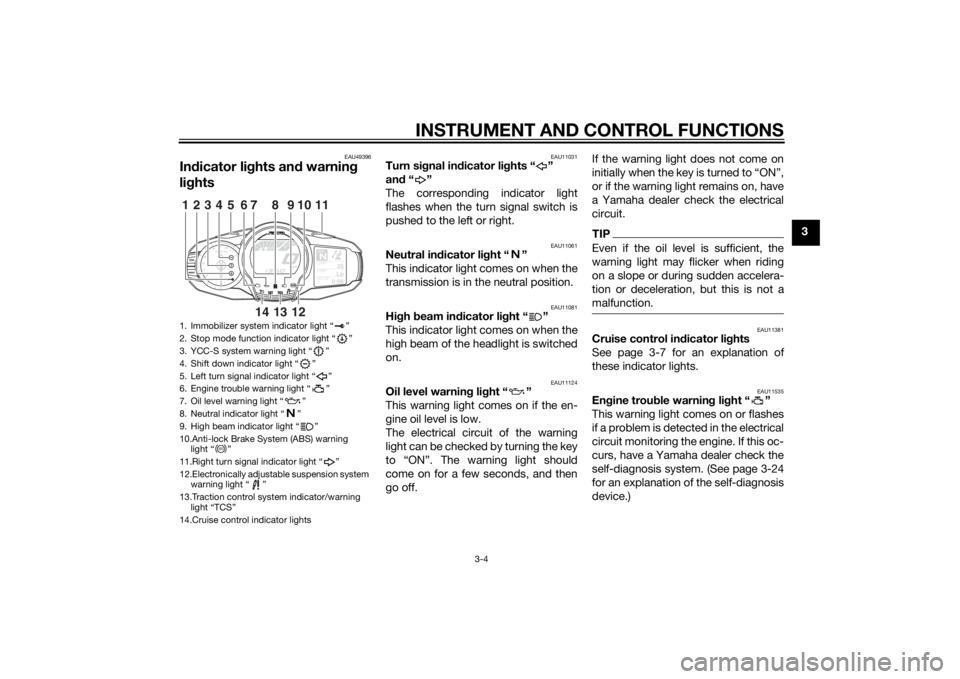
INSTRUMENT AND CONTROL FUNCTIONS
3-4
3
EAU49396
Indicator lights and warning
lights
EAU11031
Turn signal indicator lights “ ”
and“”
The corresponding indicator light
flashes when the turn signal switch is
pushed to the left or right.
EAU11061
Neutral indicator light “ ”
This indicator light comes on when the
transmission is in the neutral position.
EAU11081
High beam indicator light “ ”
This indicator light comes on when the
high beam of the headlight is switched
on.
EAU11124
Oil level warning light “ ”
This warning light comes on if the en-
gine oil level is low.
The electrical circuit of the warning
light can be checked by turning the key
to “ON”. The warning light should
come on for a few seconds, and then
go off.If the warning light does not come on
initially when the key is turned to “ON”,
or if the warning light remains on, have
a Yamaha dealer check the electrical
circuit.
TIPEven if the oil level is sufficient, the
warning light may flicker when riding
on a slope or during sudden accelera-
tion or deceleration, but this is not a
malfunction.
EAU11381
Cruise control indicator lights
See page 3-7 for an explanation of
these indicator lights.
EAU11535
Engine trouble warning light “ ”
This warning light comes on or flashes
if a problem is detected in the electrical
circuit monitoring the engine. If this oc-
curs, have a Yamaha dealer check the
self-diagnosis system. (See page 3-24
for an explanation of the self-diagnosis
device.)
1. Immobilizer system indicator light “ ”
2. Stop mode function indicator light “ ”
3. YCC-S system warning light “ ”
4. Shift down indicator light “ ”
5. Left turn signal indicator light “ ”
6. Engine trouble warning light “ ”
7. Oil level warning light “ ”
8. Neutral indicator light “ ”
9. High beam indicator light “ ”
10.Anti-lock Brake System (ABS) warning
light “ ”
11.Right turn signal indicator light “ ”
12.Electronically adjustable suspension system
warning light “ ”
13.Traction control system indicator/warning
light “TCS”
14.Cruise control indicator lights
GEARN
25
A.TEMP ˚C
Lo
C.TEMP ˚C
0:06
TIME TRIP
1234
5
11
6
10
7
13
12
14
9
8
ABS
U1MDE1E0.book Page 4 Monday, July 28, 2014 10:48 AM
Page 22 of 124
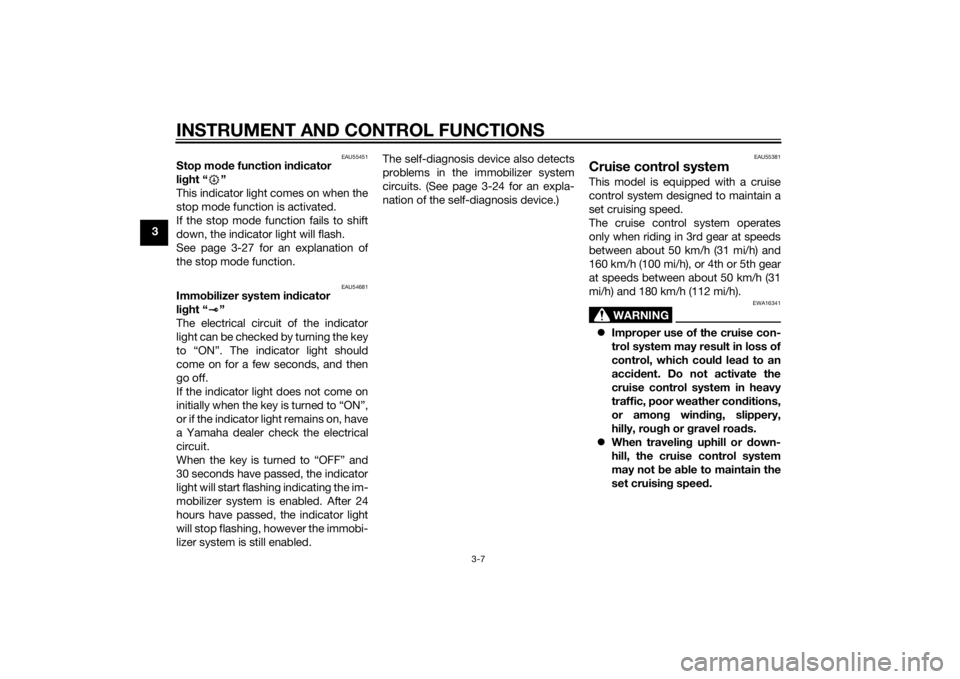
INSTRUMENT AND CONTROL FUNCTIONS
3-7
3
EAU55451
Stop mode function indicator
light “ ”
This indicator light comes on when the
stop mode function is activated.
If the stop mode function fails to shift
down, the indicator light will flash.
See page 3-27 for an explanation of
the stop mode function.
EAU54681
Immobilizer system indicator
light “ ”
The electrical circuit of the indicator
light can be checked by turning the key
to “ON”. The indicator light should
come on for a few seconds, and then
go off.
If the indicator light does not come on
initially when the key is turned to “ON”,
or if the indicator light remains on, have
a Yamaha dealer check the electrical
circuit.
When the key is turned to “OFF” and
30 seconds have passed, the indicator
light will start flashing indicating the im-
mobilizer system is enabled. After 24
hours have passed, the indicator light
will stop flashing, however the immobi-
lizer system is still enabled.The self-diagnosis device also detects
problems in the immobilizer system
circuits. (See page 3-24 for an expla-
nation of the self-diagnosis device.)
EAU55381
Cruise control systemThis model is equipped with a cruise
control system designed to maintain a
set cruising speed.
The cruise control system operates
only when riding in 3rd gear at speeds
between about 50 km/h (31 mi/h) and
160 km/h (100 mi/h), or 4th or 5th gear
at speeds between about 50 km/h (31
mi/h) and 180 km/h (112 mi/h).
WARNING
EWA16341
Improper use of the cruise con-
trol system may result in loss of
control, which could lead to an
accident. Do not activate the
cruise control system in heavy
traffic, poor weather conditions,
or among winding, slippery,
hilly, rough or gravel roads.
When traveling uphill or down-
hill, the cruise control system
may not be able to maintain the
set cruising speed.
U1MDE1E0.book Page 7 Monday, July 28, 2014 10:48 AM
Page 23 of 124
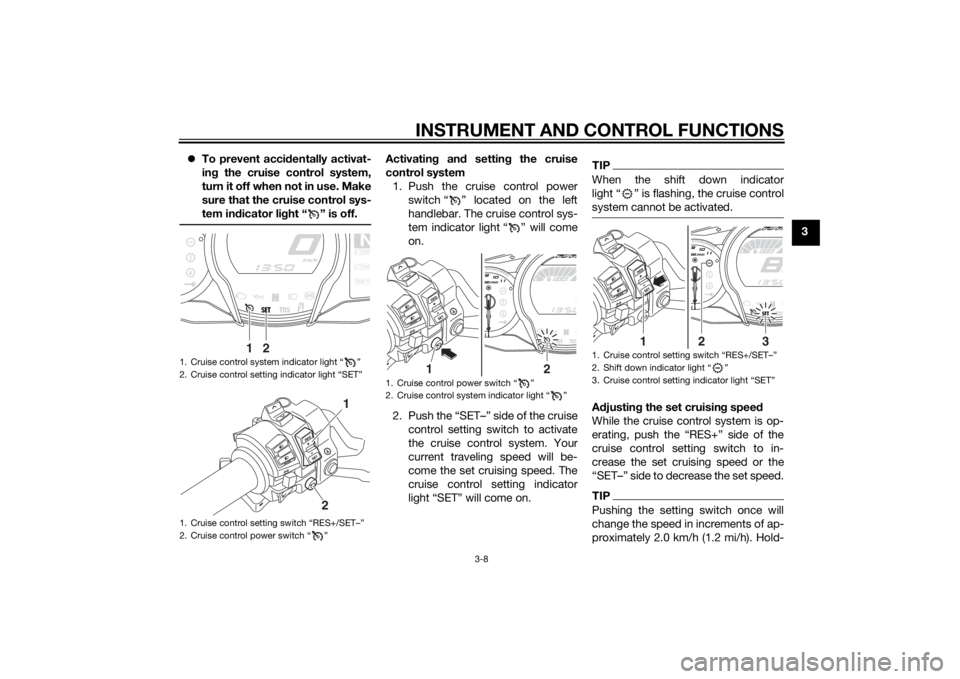
INSTRUMENT AND CONTROL FUNCTIONS
3-8
3 To prevent accidentally activat-
ing the cruise control system,
turn it off when not in use. Make
sure that the cruise control sys-
tem indicator light “ ” is off.
Activating and setting the cruise
control system
1. Push the cruise control power
switch “ ” located on the left
handlebar. The cruise control sys-
tem indicator light “ ” will come
on.
2. Push the “SET–” side of the cruise
control setting switch to activate
the cruise control system. Your
current traveling speed will be-
come the set cruising speed. The
cruise control setting indicator
light “SET” will come on.
TIPWhen the shift down indicator
light Ž is flashing, the cruise control
system cannot be activated.Adjusting the set cruising speed
While the cruise control system is op-
erating, push the “RES+” side of the
cruise control setting switch to in-
crease the set cruising speed or the
“SET–” side to decrease the set speed.TIPPushing the setting switch once will
change the speed in increments of ap-
proximately 2.0 km/h (1.2 mi/h). Hold-
1. Cruise control system indicator light Ž
2.
1.
2. Cruise control power switch Ž
NA.TEM
P
C.TEM
P
TIME T
R
2
1
1
2
1. Cruise control power switch “ ”
2. Cruise control system indicator light “ ”
2
1
1.
2. Shift down indicator light Ž
3.
2
3
1
U1MDE1E0.book Page 8 Monday, July 28, 2014 10:48 AM
Page 24 of 124
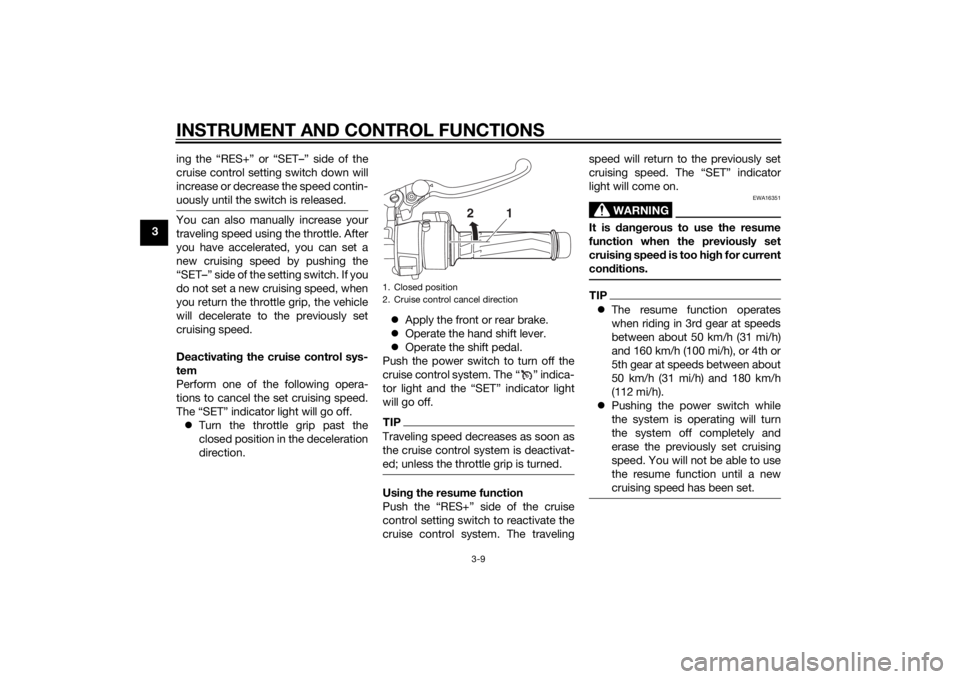
INSTRUMENT AND CONTROL FUNCTIONS
3-9
3ing the “RES+” or “SET–” side of the
cruise control setting switch down will
increase or decrease the speed contin-
uously until the switch is released.
You can also manually increase your
traveling speed using the throttle. After
you have accelerated, you can set a
new cruising speed by pushing the
“SET–” side of the setting switch. If you
do not set a new cruising speed, when
you return the throttle grip, the vehicle
will decelerate to the previously set
cruising speed.
Deactivating the cruise control sys-
tem
Perform one of the following opera-
tions to cancel the set cruising speed.
The “SET” indicator light will go off.
Turn the throttle grip past the
closed position in the deceleration
direction.Apply the front or rear brake.
Operate the hand shift lever.
Operate the shift pedal.
Push the power switch to turn off the
cruise control system. The “ ” indica-
tor light and the “SET” indicator light
will go off.
TIPTraveling speed decreases as soon as
the cruise control system is deactivat-
ed; unless the throttle grip is turned.Using the resume function
Push the “RES+” side of the cruise
control setting switch to reactivate the
cruise control system. The travelingspeed will return to the previously set
cruising speed. The “SET” indicator
light will come on.
WARNING
EWA16351
It is dangerous to use the resume
function when the previously set
cruising speed is too high for current
conditions.TIPThe resume function operates
when riding in 3rd gear at speeds
between about 50 km/h (31 mi/h)
and 160 km/h (100 mi/h), or 4th or
5th gear at speeds between about
50 km/h (31 mi/h) and 180 km/h
(112 mi/h).
Pushing the power switch while
the system is operating will turn
the system off completely and
erase the previously set cruising
speed. You will not be able to use
the resume function until a new
cruising speed has been set.
1. Closed position
2. Cruise control cancel direction
2
1
U1MDE1E0.book Page 9 Monday, July 28, 2014 10:48 AM
Page 25 of 124
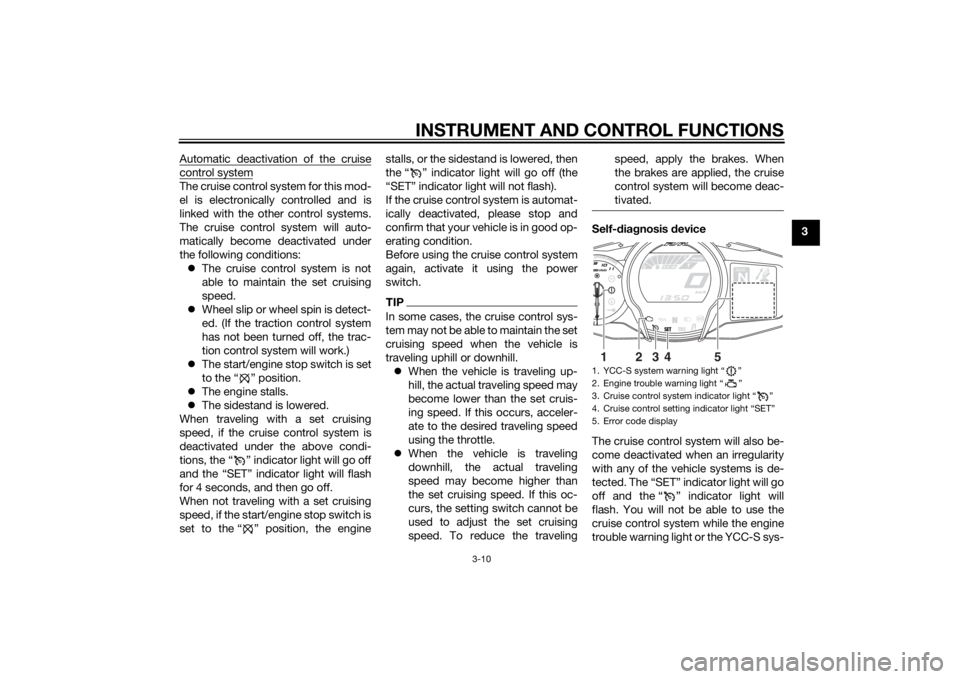
INSTRUMENT AND CONTROL FUNCTIONS
3-10
3 Automatic deactivation of the cruise
control systemThe cruise control system for this mod-
el is electronically controlled and is
linked with the other control systems.
The cruise control system will auto-
matically become deactivated under
the following conditions:
The cruise control system is not
able to maintain the set cruising
speed.
Wheel slip or wheel spin is detect-
ed. (If the traction control system
has not been turned off, the trac-
tion control system will work.)
The start/engine stop switch is set
to the “ ” position.
The engine stalls.
The sidestand is lowered.
When traveling with a set cruising
speed, if the cruise control system is
deactivated under the above condi-
tions, the “ ” indicator light will go off
and the “SET” indicator light will flash
for 4 seconds, and then go off.
When not traveling with a set cruising
speed, if the start/engine stop switch is
set to the “ ” position, the enginestalls, or the sidestand is lowered, then
the “ ” indicator light will go off (the
“SET” indicator light will not flash).
If the cruise control system is automat-
ically deactivated, please stop and
confirm that your vehicle is in good op-
erating condition.
Before using the cruise control system
again, activate it using the power
switch.
TIPIn some cases, the cruise control sys-
tem may not be able to maintain the set
cruising speed when the vehicle is
traveling uphill or downhill.
When the vehicle is traveling up-
hill, the actual traveling speed may
become lower than the set cruis-
ing speed. If this occurs, acceler-
ate to the desired traveling speed
using the throttle.
When the vehicle is traveling
downhill, the actual traveling
speed may become higher than
the set cruising speed. If this oc-
curs, the setting switch cannot be
used to adjust the set cruising
speed. To reduce the travelingspeed, apply the brakes. When
the brakes are applied, the cruise
control system will become deac-
tivated.
Self-diagnosis device
The cruise control system will also be-
come deactivated when an irregularity
with any of the vehicle systems is de-
tected. The “SET” indicator light will go
off and the “ ” indicator light will
flash. You will not be able to use the
cruise control system while the engine
trouble warning light or the YCC-S sys-1. YCC-S system warning light “ ”
2. Engine trouble warning light “ ”
3. Cruise control system indicator light “ ”
4. Cruise control setting indicator light “SET”
5. Error code display
GEARN
25
A.TEMP ˚C
Lo
C.TEMP ˚C
0:06
TIME TRIP
3
4
5
2
1
U1MDE1E0.book Page 10 Monday, July 28, 2014 10:48 AM
Page 26 of 124
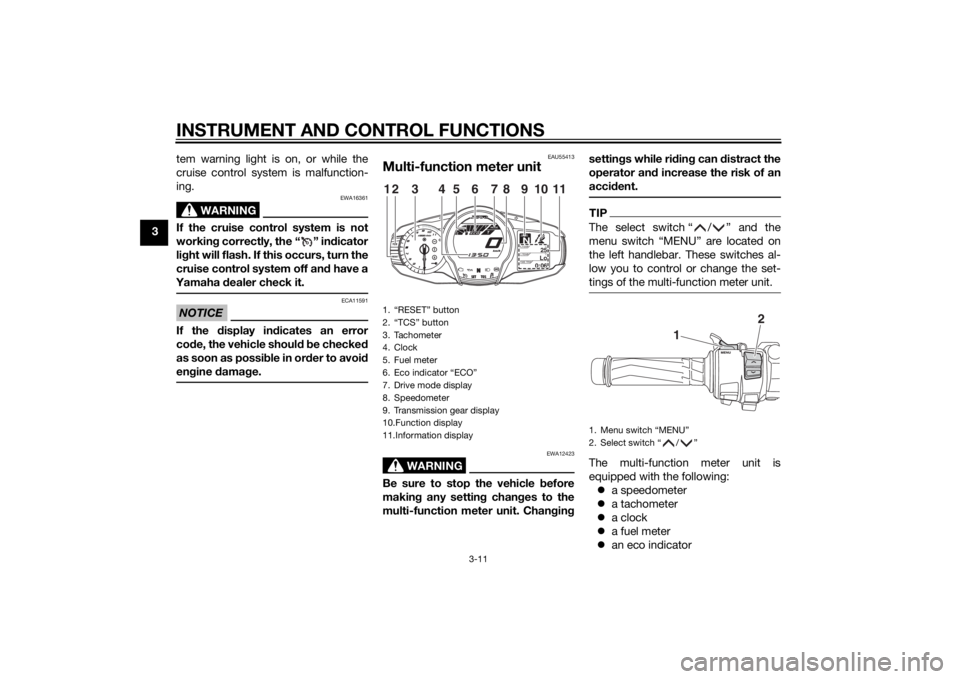
INSTRUMENT AND CONTROL FUNCTIONS
3-11
3tem warning light is on, or while the
cruise control system is malfunction-
ing.
WARNING
EWA16361
If the cruise control system is not
working correctly, the “ ” indicator
light will flash. If this occurs, turn the
cruise control system off and have a
Yamaha dealer check it.NOTICE
ECA11591
If the display indicates an error
code, the vehicle should be checked
as soon as possible in order to avoid
engine damage.
EAU55413
Multi-function meter unit
WARNING
EWA12423
Be sure to stop the vehicle before
making any setting changes to the
multi-function meter unit. Changingsettings while riding can distract the
operator and increase the risk of an
accident.
TIPThe select switch “ / ” and the
menu switch “MENU” are located on
the left handlebar. These switches al-
low you to control or change the set-
tings of the multi-function meter unit.The multi-function meter unit is
equipped with the following:
a speedometer
a tachometer
a clock
a fuel meter
an eco indicator
1. “RESET” button
2. “TCS” button
3. Tachometer
4. Clock
5. Fuel meter
6. Eco indicator “ECO”
7. Drive mode display
8. Speedometer
9. Transmission gear display
10.Function display
11.Information display
GEARN
25
A.TEMP ˚C
Lo
C.TEMP ˚C
0:06
TIME TRIP
12
3
11
4
5
8
7
6
9
10
1. Menu switch “MENU”
2. Select switch “ / ”
1
2
U1MDE1E0.book Page 11 Monday, July 28, 2014 10:48 AM
Page 40 of 124
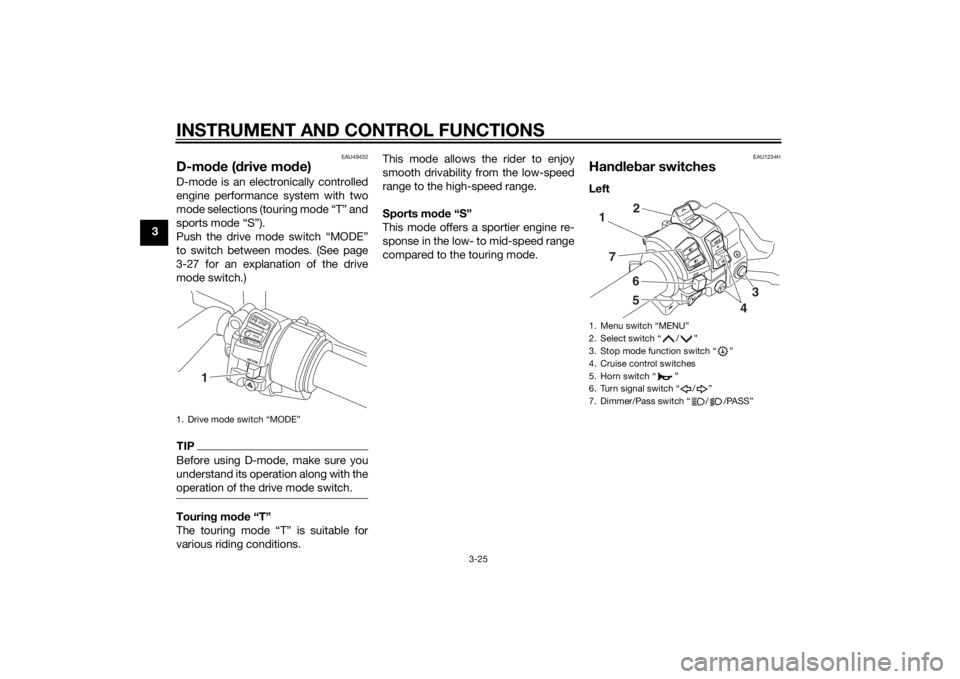
INSTRUMENT AND CONTROL FUNCTIONS
3-25
3
EAU49432
D-mode (drive mode)D-mode is an electronically controlled
engine performance system with two
mode selections (touring mode “T” and
sports mode “S”).
Push the drive mode switch “MODE”
to switch between modes. (See page
3-27 for an explanation of the drive
mode switch.)TIPBefore using D-mode, make sure you
understand its operation along with the
operation of the drive mode switch.Touring mode “T”
The touring mode “T” is suitable for
various riding conditions.This mode allows the rider to enjoy
smooth drivability from the low-speed
range to the high-speed range.
Sports mode “S”
This mode offers a sportier engine re-
sponse in the low- to mid-speed range
compared to the touring mode.
EAU1234H
Handlebar switchesLeft
1. Drive mode switch “MODE”
STOPM
O
D
ERUNSTART
1
1. Menu switch “MENU”
2. Select switch “ / ”
3. Stop mode function switch “ ”
4. Cruise control switches
5. Horn switch “ ”
6. Turn signal switch “ / ”
7. Dimmer/Pass switch “ / /PASS”17
652
4
3
U1MDE1E0.book Page 25 Monday, July 28, 2014 10:48 AM
Page 41 of 124
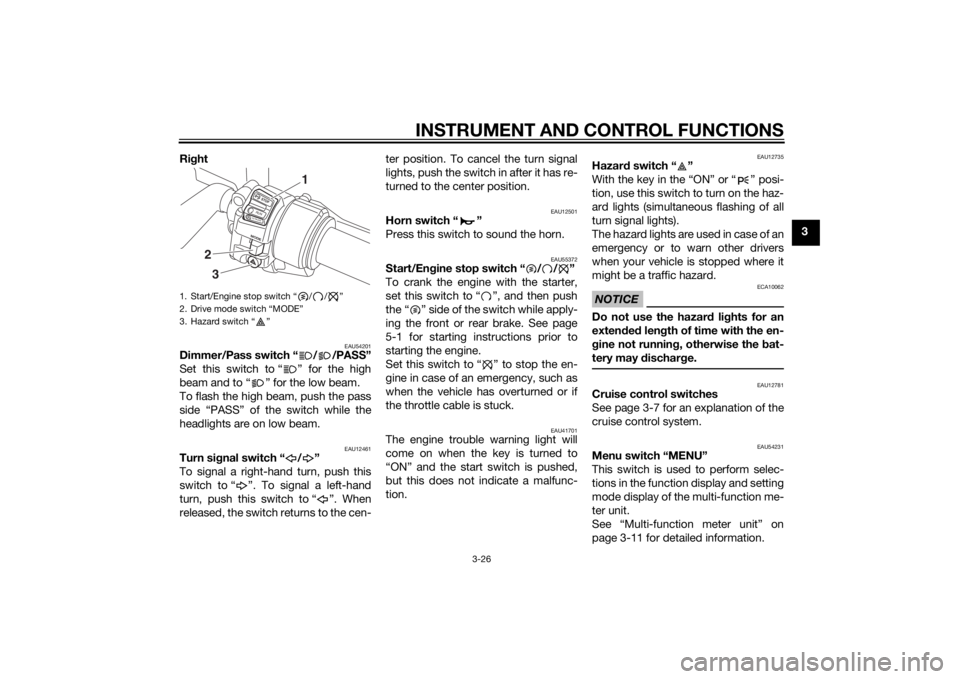
INSTRUMENT AND CONTROL FUNCTIONS
3-26
3 Right
EAU54201
Dimmer/Pass switch “ / /PASS”
Set this switch to “ ” for the high
beam and to “ ” for the low beam.
To flash the high beam, push the pass
side “PASS” of the switch while the
headlights are on low beam.
EAU12461
Turn signal switch “ / ”
To signal a right-hand turn, push this
switch to “ ”. To signal a left-hand
turn, push this switch to “ ”. When
released, the switch returns to the cen-ter position. To cancel the turn signal
lights, push the switch in after it has re-
turned to the center position.
EAU12501
Horn switch “ ”
Press this switch to sound the horn.
EAU55372
Start/Engine stop switch “ / / ”
To crank the engine with the starter,
set this switch to “ ”, and then push
the “ ” side of the switch while apply-
ing the front or rear brake. See page
5-1 for starting instructions prior to
starting the engine.
Set this switch to “ ” to stop the en-
gine in case of an emergency, such as
when the vehicle has overturned or if
the throttle cable is stuck.
EAU41701
The engine trouble warning light will
come on when the key is turned to
“ON” and the start switch is pushed,
but this does not indicate a malfunc-
tion.
EAU12735
Hazard switch “ ”
With the key in the “ON” or “ ” posi-
tion, use this switch to turn on the haz-
ard lights (simultaneous flashing of all
turn signal lights).
The hazard lights are used in case of an
emergency or to warn other drivers
when your vehicle is stopped where it
might be a traffic hazard.NOTICE
ECA10062
Do not use the hazard lights for an
extended length of time with the en-
gine not running, otherwise the bat-
tery may discharge.
EAU12781
Cruise control switches
See page 3-7 for an explanation of the
cruise control system.
EAU54231
Menu switch “MENU”
This switch is used to perform selec-
tions in the function display and setting
mode display of the multi-function me-
ter unit.
See “Multi-function meter unit” on
page 3-11 for detailed information.
1. Start/Engine stop switch “ / / ”
2. Drive mode switch “MODE”
3. Hazard switch “ ”
STOPM
O
D
ERUNSTART
32
1
U1MDE1E0.book Page 26 Monday, July 28, 2014 10:48 AM
Page 42 of 124
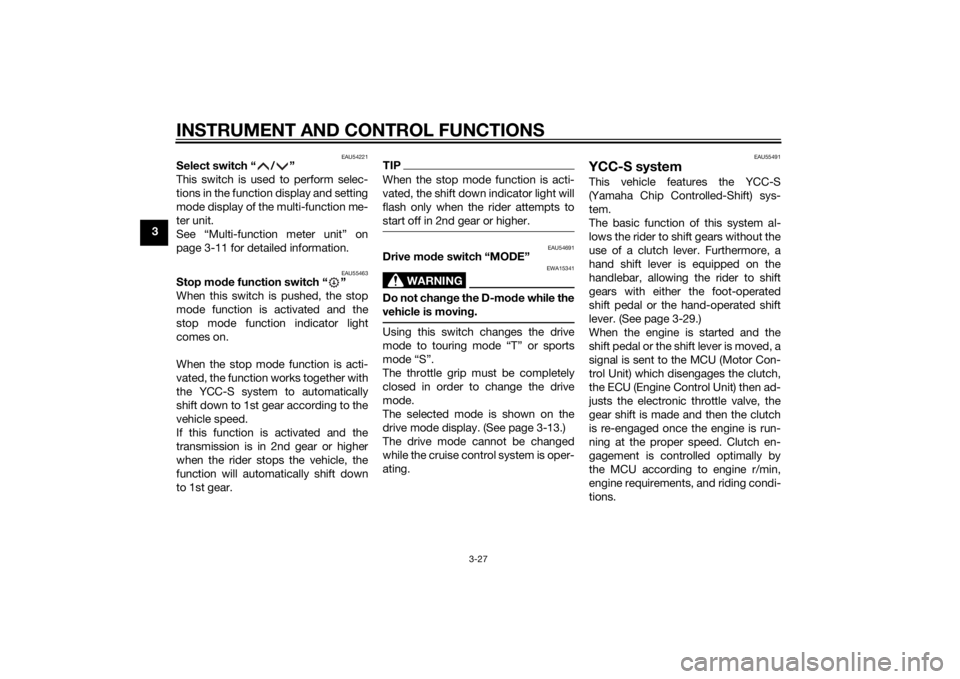
INSTRUMENT AND CONTROL FUNCTIONS
3-27
3
EAU54221
Select switch “ / ”
This switch is used to perform selec-
tions in the function display and setting
mode display of the multi-function me-
ter unit.
See “Multi-function meter unit” on
page 3-11 for detailed information.
EAU55463
Stop mode function switch “ ”
When this switch is pushed, the stop
mode function is activated and the
stop mode function indicator light
comes on.
When the stop mode function is acti-
vated, the function works together with
the YCC-S system to automatically
shift down to 1st gear according to the
vehicle speed.
If this function is activated and the
transmission is in 2nd gear or higher
when the rider stops the vehicle, the
function will automatically shift down
to 1st gear.
TIPWhen the stop mode function is acti-
vated, the shift down indicator light will
flash only when the rider attempts to
start off in 2nd gear or higher.
EAU54691
Drive mode switch “MODE”
WARNING
EWA15341
Do not change the D-mode while the
vehicle is moving.Using this switch changes the drive
mode to touring mode “T” or sports
mode “S”.
The throttle grip must be completely
closed in order to change the drive
mode.
The selected mode is shown on the
drive mode display. (See page 3-13.)
The drive mode cannot be changed
while the cruise control system is oper-
ating.
EAU55491
YCC-S systemThis vehicle features the YCC-S
(Yamaha Chip Controlled-Shift) sys-
tem.
The basic function of this system al-
lows the rider to shift gears without the
use of a clutch lever. Furthermore, a
hand shift lever is equipped on the
handlebar, allowing the rider to shift
gears with either the foot-operated
shift pedal or the hand-operated shift
lever. (See page 3-29.)
When the engine is started and the
shift pedal or the shift lever is moved, a
signal is sent to the MCU (Motor Con-
trol Unit) which disengages the clutch,
the ECU (Engine Control Unit) then ad-
justs the electronic throttle valve, the
gear shift is made and then the clutch
is re-engaged once the engine is run-
ning at the proper speed. Clutch en-
gagement is controlled optimally by
the MCU according to engine r/min,
engine requirements, and riding condi-
tions.
U1MDE1E0.book Page 27 Monday, July 28, 2014 10:48 AM